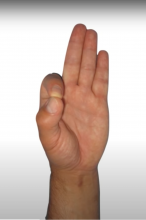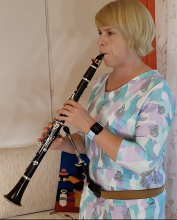Holding the Clarinet
Contributions by Interviewees
- Paolo Beltramini
- François Benda
- Alain Billard
- Alain Damiens
- James Campbell
- Eli Eban
- Steve Hartman
- Sylvie Hue 1, 2
- John Moses 1, 2
- Gerald Kraxberger
- Seunghee Lee 1, 2
- Harri Mäki 1, 2, 3
- Heinrich Mätzener 1, 2, 3
- Pascal Moraguès
- Thomas Piercy
- Frédéric Rapin 1, 2
- Ernst Schlader
- David Shifrin
- Richard Stoltzman
- Jérôme Verhaeghe
- Michel Westphal
The Work of the Thumb
See also Finger Technique
Anatomical Introduction


The anatomy of the thumb is designed to grasp powerfully, interacting with the other fingers to exert force on an object. However, holding the clarinet leads to an anatomically unfavorable weight load on the thumb joints]. The muscles that enable the thumb to move freely should be activated in an oppositional manner and stabilize the thumb in its natural shape which, together with the other fingers, forms an open C. In this way, the joints and ligaments can be spared during weight bearing.
Putting Anatomically Appropriate Weight on the Thumb
Strengthening Exercises for the Thumb
In order to maintain a natural shape of the hand while holding the clarinet, François Benda, Harri Mäki and Ernesto Molinari suggest the following procedure: when the right hand is dropped loosely next to the body, the hand is relaxed and the fingers are slightly bent. The clarinet can now be placed horizontally in the hand with the left hand, thus adopting the natural hand and finger positions for clarinet playing. The ideal hand shape can be found by loosely grasping the opposite wrist (Ernesto Molinari).
Gerald Kraxberger pays particular attention to the fact that the thumb can have different joint positions and angles depending on the playing context. A thumb that is permanently bent outwards must be avoided, as this would result in a dangerous overloading of the metacarpophalangeal joint. Michel Westphal, who often switches between different clarinets, basset clarinets, and basset horns, has likewise become accustomed to different thumb positions. In his opinion, the natural position of the thumb is in relation to the middle finger, however, he does not wish to simply give a general recommendation for the position of the thumb rest.
Carrying and Balancing
Carrying
In order to practice a holding position that ensures a good relationship between the neck, larynx and embouchure, Alain Damiens places the bell of the clarinet in his outstretched left hand and thus guides the instrument, supported by his right thumb, to the embouchure. He transfers this feeling of always bringing the clarinet from bottom to top to the normal playing position.
Seunghee Lee imagines the clarinet to be a natural extension of the body without paying special attention to the angle. The head must never tilt towards the clarinet, as this would hinder the general posture and consequently the free flow of air between throat and embouchure.
Frédéric Rapin "lets the clarinet come to the embouchure," he never tries to "reach for the clarinet." This is a view of holding is inspired by the Alexander Technique, which locates the force carrying the instrument primarily in the spine and creates a feeling that there is free space surrounding all joints. In particular, the wrists are never fixed by excessive tension. For Ernst Schlader, targeted strength training and regular physical activity are an important base for holding the clarinet in a physically correct manner: strength in the arms and back allow for a healthy holding position.
Balancing
Depending on whether the thumb rest is placed higher or lower, the clarinet can be balanced on the thumb. If the thumb rest is further down, the clarinet rests on the lower lip; if the thumb rest is further up, a torque is created which presses the clarinet slightly against the upper teeth. This can be annoying when playing with double-lip embouchure, as the pressure on the upper lip is increased.
François Benda believes that a compromise must be found between a natural position of the right hand and thumb, and a well-balanced weight of the clarinet. Pascal Moraguès also makes sure that the thumb rest is attached in such a way that both conditions are met as far as possible: the clarinet should be able to be balanced on the thumb, while at the same time the right hand and thumb must remain in their naturally rounded form. Heinrich Mätzener suggests balance exercises to strengthen the thumb.
François Benda
Alain Billard, James Campbell, Eli Eban, Sylvie Hue, Gerald Kraxberger, Seunghee Lee, John Moses, Pascal Moraguès, Harri Mäki, Frédéric Rapin, David Shirfrin, Jérôme Verhaeghe recommend placing the thumb rest so that the thumb is at the height between the index finger and ring finger. The important thing is to ensure that the whole hand is well formed in its natural shape and that no finger joints are forced.
Playing Supports

François Benda further recommends a device that supports the clarinet on the belly, combining with a strap attached to a suspension device.
The use of such a lanyard relieves the pressure on the right thumb but puts a strain on the neck and can cause tension in the neck, according to Steve Hartman and John Moses. Furthermore, the lanyard puts the clarinet at an unfavorable angle. However, if you are injured and have to play, it can be a good help.
Sylvie Hue believes that children who have small hands and not yet so much strength should be allowed to play on the Eb clarinet for longer, rather than playing the Bb clarinet with a support, which, for the reasons mentioned above, is not recommended.
Jérôme Verhaeghe remembers his childhood, when he wanted to play with the "big clarinet" from the very beginning, but had to play on the Eb clarinet first. It is important to consider this psychological aspect as well: his motivation returned when he was allowed to play in the wind orchestra in the first row, directly in front of the conductor.
In order to relieve the pressure on the right thumb, the instrument can be supported on the knees when playing in a sitting position for a longer period of time (depending on the individual height of the player). John Moses and Steve Hartman describe this technique. The latter mentions other renowned clarinetists such as https://en.wikipedia.org/wiki/Kalmen_Opperman Kalmen Opperman], Augustin 'Gus' Duques, Stanley Drucker, David Weber.
[[Harri Mäki#Distribute the weight of the clarinet between both hands|Harri Mäki] and Heinrich Mätzener also use the left hand for holding. For longer notes from c1 (g2) downwards, all tone holes in the upper part of the clarinet are closed, so that the left hand can also hold the instrument’s weight.
The Role of Holding Position in Sound
[James Campbell#Holding the clarinet|James Campbell]] sees it as a great challenge hold the clarinet correctly. Holding the clarinet in an optimal way is one of the secrets to playing the instrument successfully.
Embouchure Line and Blowing Angle
James Campbell continues: it is immediately audible when the manner of holding the instrument does not lead it in the direction of the embouchure to create a good contact so that the sound gets a good, strong core. This opinion is shared by Heinrich Mätzener and Richard Stoltzman, who also use this technique to modify the sound and intonation, for example in working on different articulation techniques.
Embouchure line and blowing angle are often mentioned together in the context of holding: Frédéric Rapin observes that the sound gains in freedom and size by moving the clarinet a little closer to the embouchure and not bringing it too close to the body.
Eli Eban and David Shifrin describe the two parameters in their function as follows
- the clarinet is pushed slightly towards the embouchure by the right hand to find the ideal embouchure line. This is necessary to allow the reed to vibrate freely.
- at the same time, the blowing angle is carefully closed a little. The jaw position does not have to be changed; the necessary pressure is created by choosing the appropriate angle. [Eli Eban#Two cog wheels in a fine Swiss watch|Yona Ettlinger]], Eban's teacher, compared the two movements - bringing the clarinet closer to the body and simultaneously moving it upwards - with two interlocking gears of a Swiss clockwork.
Instead of reducing the blowing angle, the head can be tilted slightly forwards into the neck. This technique is used by Thomas Piercy to control high notes in diminuendo.
Paolo Beltramini: with the Boehm clarinet, the tonal results are better if the angle is not too open. On the Oehler clarinet it can sound better if the angle is slightly more open. [Milan Rericha#Anblaswinkel|Milan Rericha]] recommends a blowing angle of 45° for optimal sound control, combined general posture and embouchure.
James Campbell chooses a slightly narrower angle because it allows him to relax the lower jaw. He refers to Daniel Bonade, who – because of the position of his teeth – kept the clarinet very close to the body. Combined with a high position of the tip of the reed, this results in a very well-focused sound.
Playing the clarinet as close to the body as Daniel Bonade used to do requires a particular structure of the upper and lower jaws. With teeth in a normal position, an overly narrow blowing angle would exert too much pressure on the lower lip. John Mosesalso mentions this. However, if the angle is too open, there is a risk of losing control of the sound.
Harri Mäki nimmt brings the clarinet a little closer to his body at crescendi, resulting in a better, less sharp timbre. Finally, the intonation can also be influenced by the angle of attack: a narrower angle raises the pitch.
Heinrich Mätzener: when the clarinet is brought closer to the body, the embouchure line should also be a little lower.
Historical Treatises
Instruments without a Thumb Rest
Amand Vanderhagen begins the first chapter of his méthode:
„article est très interessant pour les Commençants, tant pour acquérir de la grâce en jouant, que pour éviter la gêne qui résulte ordinairement des mauvaises positions; il faut donc, en portant la clarinette à la bouche, ne point avancer la tête, ni la baisser, parce que cela empêche de respirer librement."“
„This chapter is very important for beginners, both to achieve gracefulness in playing and to avoid the discomfort that usually results from bad postures. Consequently, when the clarinet is placed against the mouth, one must not under any circumstances stretch or tilt the head forward, as this prevents free breathing.“
Franz Joseph Fröhlich
With the earlier 6-keyed instruments, the work of holding the clarinet – without a thumb rest – was organized in various grip combinations using the thumb and the remaining fingers of the right hand. A reference to this can be found in Franz Joseph Fröhlich's teaching work from 1811[2]:
„Den rechten Daumen setzte man unter das Clarinett zwischen dem Zeige-und Mittelfinger (besser etwas tiefer, als zu hoch, weil das Clarinett meisten Theils [also nicht nur!] die Haltearbeit von diesem Finger erhält)... Der rechte Daumen als die Hauptstütze des Instrumentes, darf nie von seinem Platze kommen."“
„The right thumb was placed under the clarinet between the index and middle finger (better a little lower than too high, because the clarinet receives most of its holding power from this finger)... The right thumb, as the main support of the instrument, must never come out of its place.“
Frédéric Berr
The role of the left hand in holding the clarinet is clearly described in Frédéric Berr's "Méthode complète"(1836)[3]:
„Le poids de l'instrument repose en partie sur la main gauche...“
„The weight of the instrument is partly on the left hand...“
For tonal and physiological reasons, as well as for historical reasons, it makes sense to include the left hand in the work of holding the clarinet. In many situations it is possible to achieve more ease in finger technique by dividing the weight load between the right and left hand.
Instruments with a Thumb Rest
Iwan Müller, Carl Baermann
The thumb rest for the right hand only came into use after Iwan Müller had pushed ahead with innovations in instrument making around 1812: his new 13-key "clarinette omnitonique"„clarinette omnitonique“[4] made playing in all keys possible, and key mechanisms simplified the movements. New and simpler fingering combinations were created, replacing the forked fingerings. As a result, the short notes f' f sharp' and g' could now also be played without the involvement of the right hand ("covering" to correct intonation).
The technique of shifting the clarinet's weight exclusively to the right thumb by means of the thumb rest made holding the instrument more static, and increased the risk of overloading the lower thumb joint. The invention of the right thumb rest – which enabled legato playing between h1 and cis2 – and the increasing weight of the instruments also changed the static nature of the holding position. This technique of bringing the clarinet to the embouchure with gentle pressure, thereby influencing the control of the reed, receded into the background. However, holding the instrument exclusively with the right thumb runs the risk of involving the jaw muscles in the holding work and exerting too much pressure on the reed. With this increased embouchure pressure, it is no longer possible to play with double-lip embouchure.
Since the invention of the thumb rest and since the further development of the key system, one of the greatest challenges has been to avoid biting the mouthpiece during embouchure in compensation for part of the work of holding the clarinet. Were it possible with the six-keyed instrument to use both hands for balance while playing without a thumb rest and with a fork grip, the stability when playing with the side keys – operated by the right index finger – would be somewhat lost. This could be compensated for with a mandibular embouchure, where the teeth have firm contact with the mouthpiece. See Carl Baermann, Clarinet School p.5:
„...und die Sicherheit wenigstens die doppelte ist.“
„...and the safety is at least doubled.“
In contrast to this is the remark of Frédéric Berr, who taught maxillary embouchure with double-lip embouchure in Paris around 1830:
„Le célèbre Baermann nous a fait entendre en 1818 à Paris des sons pianissimo qui étaient tout-à-fait inconnus en France. Il jouait des phrases de quatre mesures avec beaucoup de force, et il les répétait en écho avec tant de douceur qu’on aurait cru que les sons venaient d’une salle voisine...
Je conseillerais de tenir en garde contre une mauvaise habitude qui existe en Allemagne: c’est de mordre sur le bec. Ce défaut donne une mauvaise qualité de son, et nuit à la flexibilité de l’expression.“
„The famous Baermann let us hear pianissimo sounds in Paris in 1818, which were completely unknown in France. He played four-bar phrases with great power and repeated them with such a gentle echo that one might think the sounds were coming from a neighboring room...
However, I advise you to be careful of a bad habit that occurs in Germany: biting the mouthpiece. This mistake gives a bad sound quality and destroys the expressive flexibility.“
Literature
- Christoph Wagner, Ulrike Wohlwender: Hand und Instrument. Musikphysiologische Grundlagen. Praktische Konsequenzen. Breitkopf und Härtel, Wiesbaden 2005
References
- ↑ Amand Vanderhagen: Méthode Nouvelle et Raisonnée pour la clarinette. Boyer, Paris, 1785. elearning.hslu.ch
- ↑ 2,0 2,1 Franz-Joseph Fröhlich: Vollständige theoretisch-pracktische Musikschule für alle beym Orchester gebräuchliche wichtigere Instrumente zum Gebrauch für Musikdirectoren - Lehrer und Liebhaber; Clarinettenschule. Simrock, Bonn 1811 (Bayerische Staatsbibliothek digital).
- ↑ 3,0 3,1 Frédéric Berr: Méthode complète de Clarinette, adoptée au Conservatoire de Musique de Paris. J. Meissonnier, Paris 1836.
- ↑ Eric Hoeprich: The clarinet, P. 133. Yale University Press, New Haven und London 2008
- ↑ Carl Baermann: Vollständige Clarinett-Schule: von dem ersten Anfang bis zur höchsten Ausbildung des Virtuosen; Erster Theil Op.63. Johann André, Offenbach/Main 1861. Bayerische Staatsbibliothekdigital
- ↑ Berr, Frédéric. 1836. Traité complet de la clarinette à 14 clefs: manuel indispensable aux personnes qui professent cet instrument et à celles qui l'étudient. Paris: E. Duverger, p.8 Gallica
